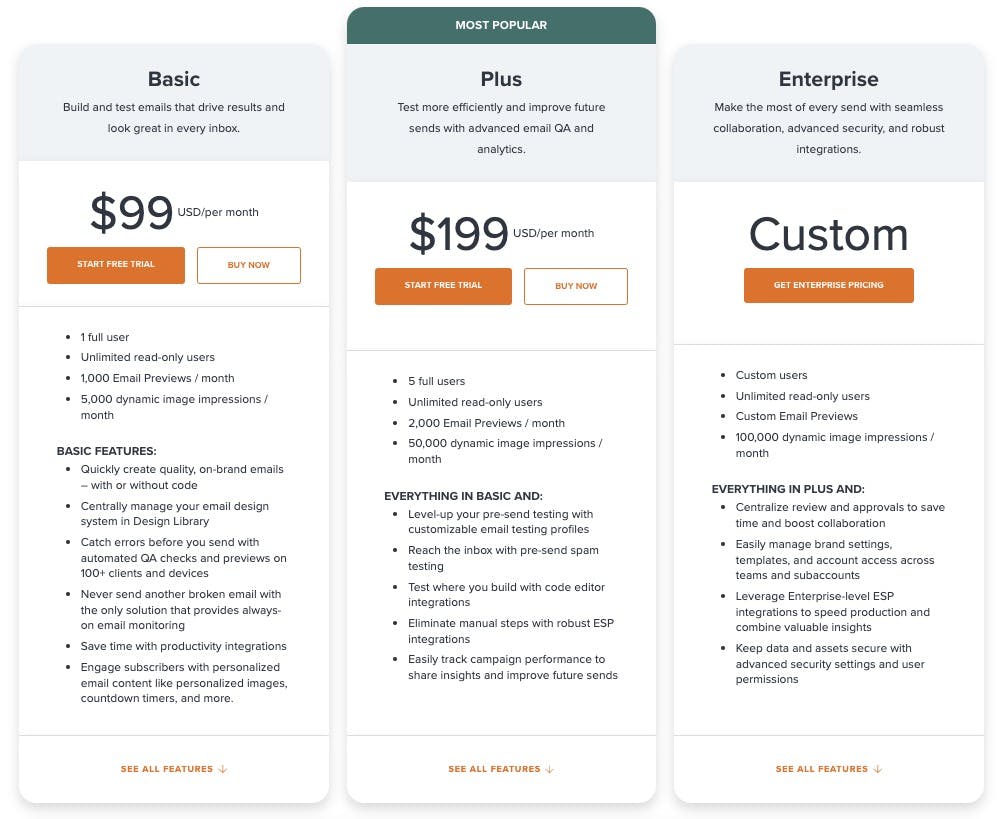
Revenue
$42.00M
2022
Growth Rate (y/y)
20%
2022
Funding
$79.00M
2019
Revenue
Litmus launched and operated as a self-funded business until 2015, hitting $1M in revenue in 2010. They raised a $49M Series A from Spectrum Equity in 2015.
Valuation
Litmus has raised a total of $79M across two funding rounds. Their most recent funding was a Series B round led by Belden, a strategic investor in the industrial technology space.
Product

For email developers, Litmus’s code editor reportedly lacks many of the developer-centric touches that they’ve come to expect either from their home IDE of choice (Sublime Text, Atom, VS Code, etc.) or from newer tools like Parcel.
That includes features around the writing of code like the lack of a code linter, as well as the lack of client-specific syntax highlighting and formatting to help write e.g. Outlook-specific email code.
The core reason for an email developer to use Litmus’s email coder would be that their organization already pays for Litmus either for its testing/previewing capabilities or for a non-technical marketing team to use to build emails.
Notably, Litmus today touts integrations with desktop IDEs like Atom, Dreamweaver, Brackets, and Sublime Text that give developers working in their IDE access to Litmus features.
Developer workflow
Developers who are building email functionality into their products at companies like Podia and Beacons use Litmus to help ensure that the features they’re building generate emails that will look the same across the many clients and devices that their customers might be using.
During the development process, they might use an email block coded in React to generate an email that gets sent into a Litmus inbox that automatically generates previews and QA for Apple Mail, Gmail, Outlook, and so on. Then, they can spot check those previews for any problems.
Finally, they’ll either modify their application code to adjust, or they’ll make smaller tweaks inside Litmus’s code editor directly.
Some companies that use Parcel for coding marketing emails keep an active Litmus account for emails that don’t need the fine-grained coding features of a Parcel, or for departments/teams that aren’t on paid Parcel seats.
At Figma, for example, the marketing operations team that owns all marketing email across the organization writes all emails in Parcel. Transactional emails are run by the product and engineering team, and they use Litmus to test those. The product and engineering teams share one paid Litmus account to do that.
Integrations
The typical workflow for an email developer or marketer using Litmus (or any similar email design tools) to send emails was that they would copy and paste HTML into Litmus (or send it to a special Litmus email address), edit it, and then export or download it for importation into their ESP.
Over the years, Litmus has been taking steps towards removing the manual, copy-and-paste, import-export dynamics of creating and sending emails via Litmus. With select ESPs, Litmus can sync directly into the ESP, eliminating the step of moving HTML from app to app.
In addition, the Litmus Chrome Extension gives users the ability to get Litmus previews directly inside their existing ESP—the extension is available to users of Campaign Monitor, Klaviyo, Mailchimp and Pardot (on the Plus plan) and Salesforce, Acoustic Campaign, Marketo, Eloqua, Responsys, and Adobe Campaign Standard (on the Enterprise plan).
Business Model

Litmus is a subscription SaaS company that prices primarily based on the number of seats a customer needs and the number of email previews they use per month.
The Basic plan ($99/month) allows for one user (though sharing a login is possible) with 1,000 email previews included. The upgraded Plus plan ($199/month) bumps that up to 5 read and write users with 2,000 email previews included.
Companies that need more than that pay a custom price on Litmus’s Enterprise plan—Mark, formerly at Rebel Mail, reported getting quoted $20,000 per month prior to their acquisition by Salesforce.
One factor that drives many forced upgrades to a custom priced plan is that Litmus counts each client and device as a separate preview—by testing an email on all ~100 different clients Litmus supports, a team will instantly run through 1/10 of their allotted previews on the Basic plan.
We talked to folks who mentioned that they’re highly conscious of Litmus’s steep pricing curve and in turn, share logins and throttle their own usage of the preview function (i.e. by limiting the clients and devices that they test on) in order to stay below the threshold that would put them on a Plus or Enterprise plan.
Brand
Litmus has been active for nearly 20 years and over that time, they’ve built up one of the strongest brands in the email marketing and development space.
Their website brings in ~500K visits per month, and 700,000 people—including 80% of Fortune 100 companies—use Litmus.
Their conference, Litmus Live, has been one of the core conferences in the email world since its first iteration in 2013 as “The Email Design Conference”. The Litmus blog was, for years, one of the best sources of information for all things around email development and design.
Just as Customer.io was early in positioning a brand around the practice of using data to inform email sends, Litmus was early in positioning a brand around the idea of email design, testing, and development.
Litmus’s years-long practice of writing blog posts about email optimization and design has helped them cement that brand with both developers and marketers—one email developer we talked to recalled that finding Litmus blog post for specific problems like making images render in specific clients was key to their impression of Litmus’s trustworthiness.
Competition
While Litmus largely stands alone in terms of end-to-end suites for testing, writing and designing emails, Litmus competes to some extent with email coding tools like Parcel, email testing products like Email on Acid, and WYSIWYG/code email builders like Dreamweaver.
Parcel
For email developers, Litmus is primarily seen as an email preview tool, with its main strength being that it allows them to preview how emails will appear across 100+ different platforms and devices.
Litmus has a coding environment as part of its platform, but it isn't its primary function—and Parcel customers that we talked to were unanimous in preferring Parcel’s editor, particularly for the Chrome Dev Tools-like “inspect” experience and the inline feedback & approvals workflow elements.
Parcel is the flip of Litmus—where Litmus is seen as an email preview platform with an email coder incidentally built in, Parcel is an email coding platform with a preview platform built in. When it was initially introduced, it didn't even have inbox previews, highlighting its primary role as a coding and collaboration platform for emails.
Dreamweaver
About 29% of email developers use Adobe Dreamweaver to write emails—many of them get it for free as part of their Creative Cloud bundle. Reinforcing those bundle effects is the fact that Adobe Photoshop, Adobe Illustrator, and Adobe InDesign are the three most popular software packages for email graphic design—a company that uses any of these for graphic design will most likely have free access to Dreamweaver. The downside of Dreamweaver is that it wasn’t designed for email.
TAM Expansion
A decade ago, a company’s entire email production process might have taken place from end-to-end inside an ESP like Mailchimp. Today, different silos across the company from marketing to product, research, and sales are all sending their own emails. In many cases, they’re all using different tools. Inside the same company, Marketo might be used to send out marketing newsletters, HubSpot might be used to send text-based emails following up with leads, and Customer.io might be used to send out transactional and product-based emails.
They’re also not necessarily keeping a comprehensive view of the customer in any one of these tools. Instead, they’re piping data in and out using a CDP.
With this proliferation of tools used to send email and the increasing complexity of the tech stack behind them, there’s a need for tools for creation that are decoupled from the data and sending side, like Litmus—tools that can allow teams to ensure that the messaging they're sending will be accessible, will fit their brand, and will be received consistently by their users regardless of platform.
News
DISCLAIMERS
This report is for information purposes only and is not to be used or considered as an offer or the solicitation of an offer to sell or to buy or subscribe for securities or other financial instruments. Nothing in this report constitutes investment, legal, accounting or tax advice or a representation that any investment or strategy is suitable or appropriate to your individual circumstances or otherwise constitutes a personal trade recommendation to you.
This research report has been prepared solely by Sacra and should not be considered a product of any person or entity that makes such report available, if any.
Information and opinions presented in the sections of the report were obtained or derived from sources Sacra believes are reliable, but Sacra makes no representation as to their accuracy or completeness. Past performance should not be taken as an indication or guarantee of future performance, and no representation or warranty, express or implied, is made regarding future performance. Information, opinions and estimates contained in this report reflect a determination at its original date of publication by Sacra and are subject to change without notice.
Sacra accepts no liability for loss arising from the use of the material presented in this report, except that this exclusion of liability does not apply to the extent that liability arises under specific statutes or regulations applicable to Sacra. Sacra may have issued, and may in the future issue, other reports that are inconsistent with, and reach different conclusions from, the information presented in this report. Those reports reflect different assumptions, views and analytical methods of the analysts who prepared them and Sacra is under no obligation to ensure that such other reports are brought to the attention of any recipient of this report.
All rights reserved. All material presented in this report, unless specifically indicated otherwise is under copyright to Sacra. Sacra reserves any and all intellectual property rights in the report. All trademarks, service marks and logos used in this report are trademarks or service marks or registered trademarks or service marks of Sacra. Any modification, copying, displaying, distributing, transmitting, publishing, licensing, creating derivative works from, or selling any report is strictly prohibited. None of the material, nor its content, nor any copy of it, may be altered in any way, transmitted to, copied or distributed to any other party, without the prior express written permission of Sacra. Any unauthorized duplication, redistribution or disclosure of this report will result in prosecution.